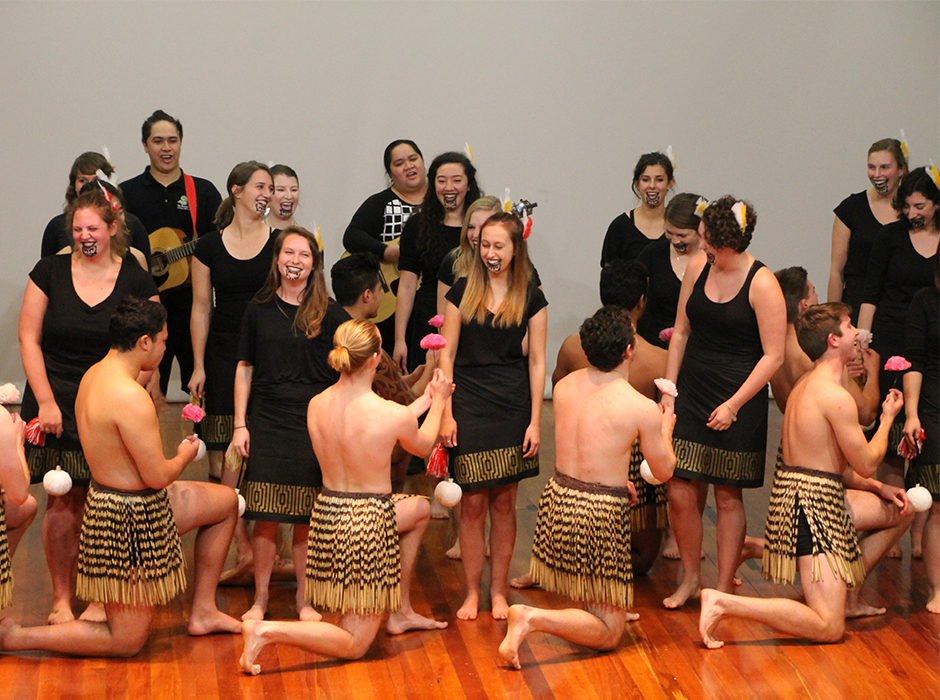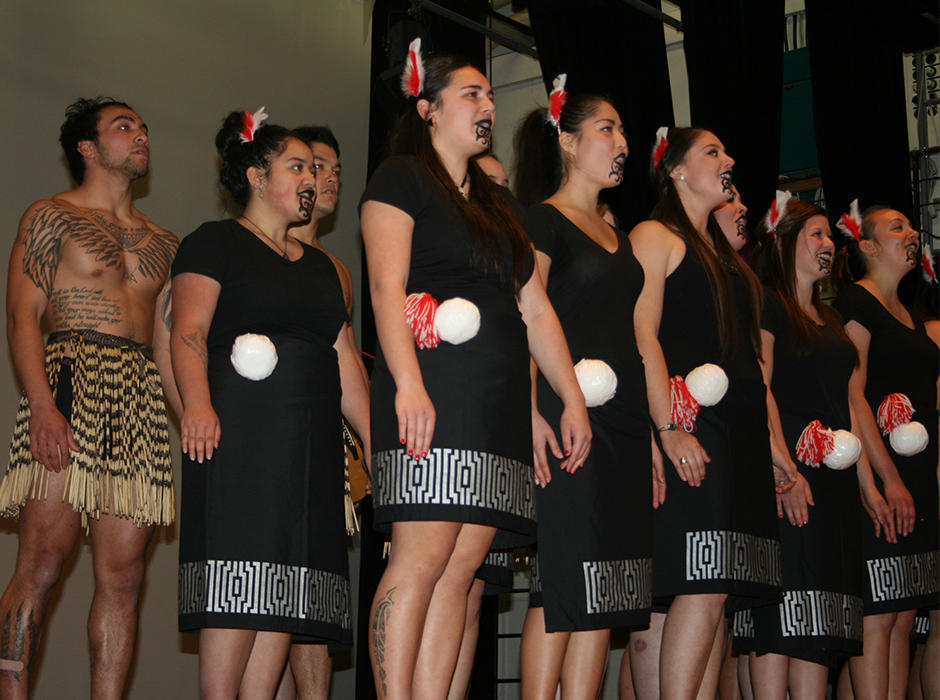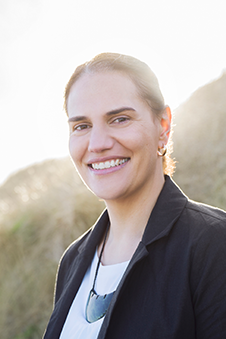
One of Associate Professor Karyn Paringatai's favourite photos from a previous concert. "The girls are in genuine shock because they had no idea the boys were going to do that. We pulled a sneaky on them!"
The stage is set to be packed for the MAOR108 concert this semester as the number of students enrolled in the paper reaches a record high.
MAOR108 Waiata: Te Tīmatanga is an introduction to various forms of waiata and haka. It culminates at the end of the first semester with a concert showcasing everything the students have learned.
While the paper typically attracts around 40-50 students, numbers this semester have swelled to over 90.
“If we’d had over 100, we would have had to add a third stream of the practicum because there’s no stage big enough that can actually fit 50 people,” MAOR108 lecturer Associate Professor Karyn Paringatai says.
“There’s a reason why Te Matatini groups – the top-level senior groups – only have 40 on stage at a time. And they are high-level performers who’ve been performing for years and years. We’ve got over 50 complete newbies in the class who’ve never swung a poi or done a haka before.”
Shifting demographics go some way to explaining the recent rise in popularity, she says.
“About 80% of the class used to be international students. Then Covid came along and there were no international students, but we saw a rise of domestic students coming through who made up our usual 40 or 50.
“We’re now up to the same numbers of international students as pre-Covid but we haven’t lost the domestic numbers. It’s become a really diverse class.”
The paper appeals to people for different reasons, Karyn says. International students love it because they get to take something tangible back home to show to their friends and families.
“For our domestic students, maybe they’re wanting to continue something they might not have been able to do at high school but absolutely loved at primary school. For our Māori students, this is their release, a safe space. They’re the experts here, which is really mana enhancing for them.”
For Karyn, who received a Prime Minister’s Supreme Teaching Excellence Award in 2014, the biggest change to the paper hasn’t been due to Covid. It was the introduction of teaching in the dark in 2013.
“Often when you make mistakes in the light people look at you. Like, you’re the reason why we have to start again … In the dark no can see if you make a mistake.” – Karyn Paringatai
“Everywhere in the country when you learn waiata, the words are stuck up on the wall, or you’re given a handout, and it doesn’t make you learn those words off by heart. The students were taking far too long to learn a really simple song for my liking, and they had assessments and a concert to do.
“I thought, we can do this better.”
Inspired by pre-European teaching methodologies and accounts of people learning waiata at night in bed at marae, they started teaching waiata in a pitch-black room.
‘We tried it in there and then we got some research funding and tried it for a whole semester and did some questionnaires and focus groups. Our original aim was just to improve pronunciation and the retention and recollection of knowledge.
“But there was a whole lot more that we hadn’t banked on. We taught things much quicker than we anticipated so we were able to increase the number of songs we taught. And because they learnt the words more quickly, when they went to learn the actions they could concentrate fully on how to perform the items, which made them better performers, which increased their grades.”
There are also fewer distractions in the dark (and a firm no cellphones in class rule) and students don’t worry so much about making mistakes, Karyn says.
“Often when you make mistakes in the light people look at you. Like, you’re the reason why we have to start again. All eyes on you. So that means you retreat, and you don’t sing as loud and that’s not good for the overall volume of the class. In the dark no one can see if you make a mistake.”
Through this change to teaching in the dark, the teaching staff were able to refocus their priorities on the language, she says.
“The most important thing about haka and waiata are the words and here we were teaching using a pedagogy that didn’t prioritise that. And now we do.”
MAOR108 student Kristy Pittman is at Otago on a Tūrangawaewae, Pōkia Whenua exchange from the University of British Columbia, Vancouver. Her iwi are Yurok, Karuk, Chetco and St'át'imc from Turtle Island/North America. This is her first experience with learning in the dark.
“When Karyn spoke about learning in the dark and her research, I was so excited because it all made so much sense. The traditional knowledge of learning is so powerful and an untapped way to connect with our Ancestors. I enjoy the time it takes to be still, peaceful and focusing on the words of the songs.
“I am still on my language journey of learning Yurok and St’át’imcets and I know it will be a lifelong journey for me and my family. This paper has been healing for me because not knowing te reo Māori but knowing I can do hard pieces has helped me to apply that to my own language journey. I have a sense of pride and accomplishment and feel more connected to the lands and people here.”

MAOR108 introduces students to different styles of performance and the different reasons why people compose waiata and haka in the context of broader Māori society and culture. The paper culminates in a concert showcasing everything the students have learned during the semester.
Falling in love with kapa haka

Karyn Paringatai
“There’s not one event, not one occasion, where a haka or waiata of some sort is not performed. You can’t get away from that attachment to identity.”
Karyn Paringatai has one major goal when teaching her MAOR108 paper.
“My job is to get my students to fall in love with haka and waiata the way I love haka and waiata.”
While the haka has been done by sports team for over 100 years, people still don’t understand what they’re all about, Karyn says.
“Haka and waiata are expressions of emotions embedded in every single part of Māori society. Kapa haka teaches us about our histories, teaches us about our whakapapa, our values and our narratives, about prominent people in our histories, about our responsibilities and obligations.
“There’s not one event, not one occasion, where a haka or waiata of some sort is not performed. You can’t get away from that attachment to identity.”
MAOR108 introduces students to different styles of performance and the different reasons why people compose items in the context of broader Māori society and culture.
“We recently looked at the concept of aroha. We spent about 20 minutes just discussing that and getting the students to understand what aroha is and then recognise that a waiata aroha is about the absence of that and what happens when your whole world has revolved around something and suddenly it’s taken away from you.
“When we did waiata tangi we looked at Māori narratives around death and the loss of something. Not necessarily the loss of love but the loss of something or someone, going as far as the loss of land and laments being composed about that. So we teach all the context before we actually get into the items.”
Throughout the semester, students are assessed on three or four items to demonstrate they know the words and their meaning, the actions, the tunes and how to perform them, Karyn says.
“But there’s no exam at the end. The concert is their exam.”
Students receive a group mark for the concert, which is not so much an assessment of how well they’ve executed each item but of how much fun they’re having, Karyn says.
“I talk about the intangible x-factors of performance – ihi, wehi and wana.
“I always describe ihi as this energy that radiates from the performer when they’re performing and that’s tenfold when you’ve got a whole group of performers who are all radiating that energy.”
Wehi is the response of the audience to the performance and wana is the combination of those two things.
“It’s the aura that sits over the whole entire performance. It’s something that’s only there in an act of performance and only really lasts for that time.”
For more information about MAOR108
- Kōrero by Laura Hewson, Internal Communications Adviser